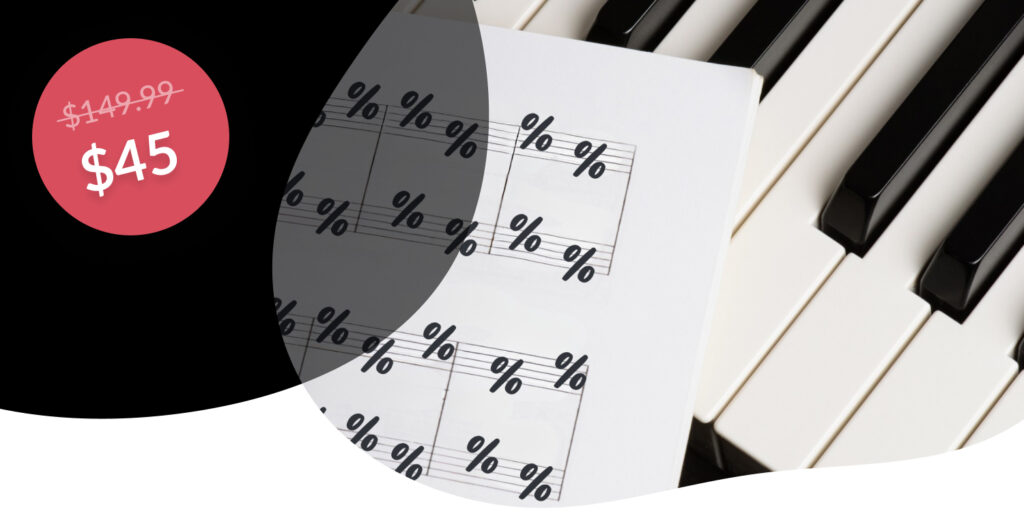The diminished chord is one of the most useful and often misunderstood sounds in music theory. To many people, it sounds quite dissonant and unattractive. The diminished chord is very useful when used properly. The dim chord, as it is also known, has interesting intervallic properties that we can study and incorporate into many musical situations. Understanding this chord is a vital part of music theory and a must have piece of harmonic vocabulary for any musician. This Skoove article is here to help you understand how to play, construct and use this useful chord. Read on to learn the secrets of the diminished chord in music theory!
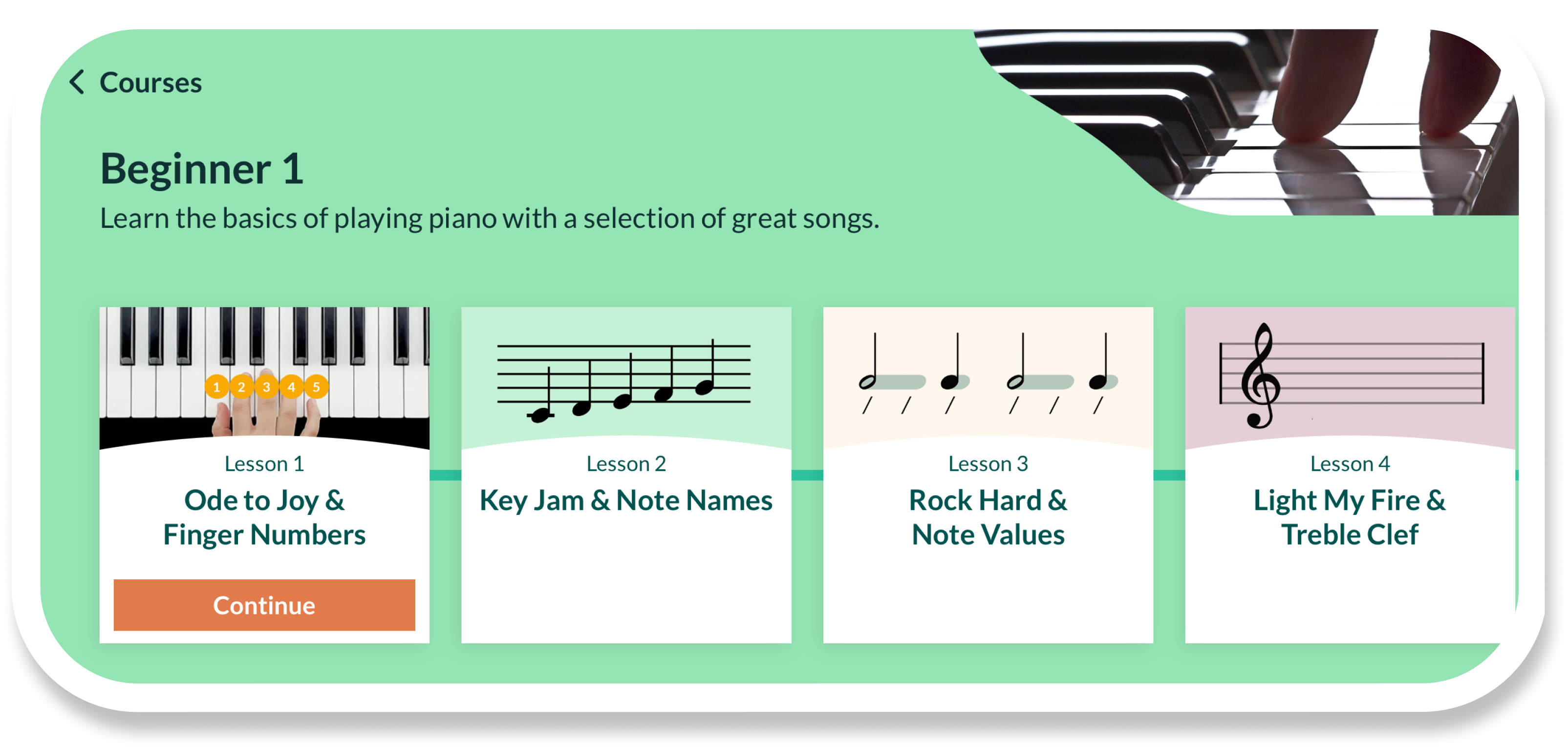
What is a diminished chord?
Diminished triads are three note chords composed of two stacked minor third intervals. Remember, a minor third interval is equal to three semitones, or three keys on the piano just like this.
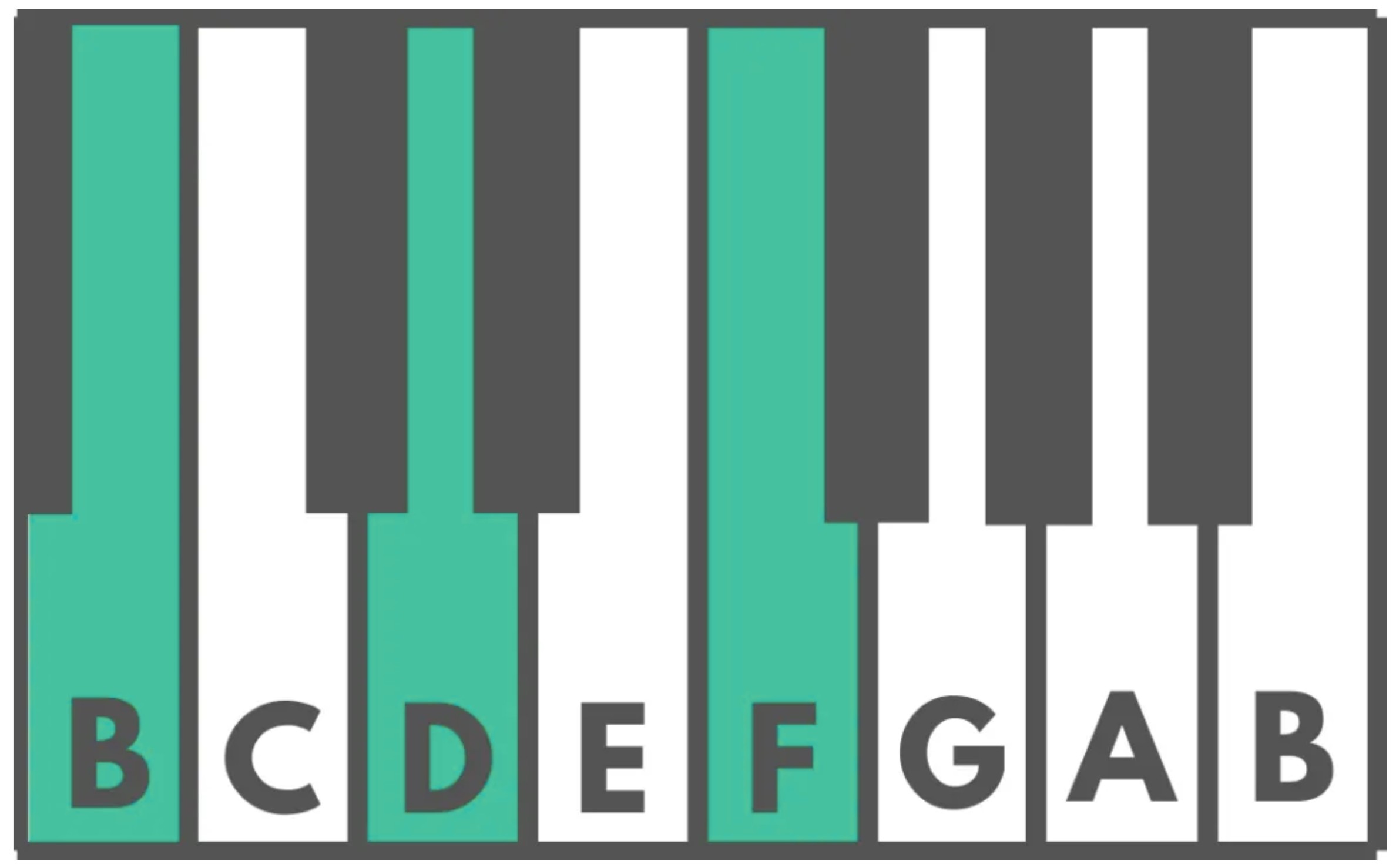
The diminished chord symbol is a small circle and is placed next to the letter of the chord symbol showing the diminished quality of the chord.
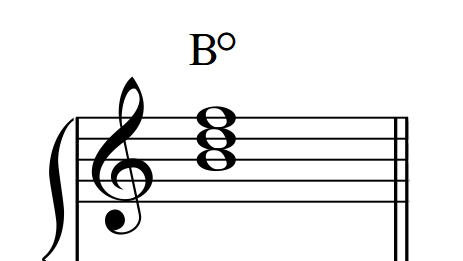
Types of diminished chords
Let’s look at all the various types available and how to make diminished chords.
Diminished triad
As we know, diminished chords are a stack of two minor thirds. Diminished triads are the three note chords that naturally occur on the seventh degree of the major scale. All major scales have a particular ascending progression of chord qualities. The pattern of chords for all major scales is:
Major – Minor – Minor – Major – Major – Minor – Diminished
The notes ofthe C major scale are C – D – E – F – G – A – B – C. If we stack thirds, creating all the diatonic triads in this major scale, we come up with the following chords:

If we consider the chords and scale degrees we see that the diminished chord is built on the leading tone (7th note). The leading tone resolves its tension to the tonic (1st note) of the scale. This tension is the defining factor in a dim chord’s sound.
Let’s review how this diminished triad relates to both major and minor chords to understand the theory behind these fundamental piano chords.
- The formula for any major triad is 1 – 3 – 5 (C – E – G).
- Minor triads have flat third degrees, compared to a major chord. The formula for any minor triad is 1 – ♭3 – 5 (C -E♭ – G).
- Diminished triads have a flat fifth degree compared to a minor chord. The formula for a diminished triad is always 1 – ♭3 – ♭5 (C – E♭ – G♭).
The flattening of the fifth means that the fifth is ‘diminished’ which is where the name of the chord comes from. This combination of intervals is what gives the diminished chord its unique harmonic properties whether as a single harmonic unit or broken chord.
Diminished chord formula
Let’s have a more in depth look at how to create three note diminished chords with a few examples.
C diminished
If we start frommiddle C and count up a minor third, we find E♭. If we count up another minor third from E♭, we find G♭. This means that a C diminished triad (C dim) is C – E♭ – G♭. This is how it looks on piano. Give it a try.
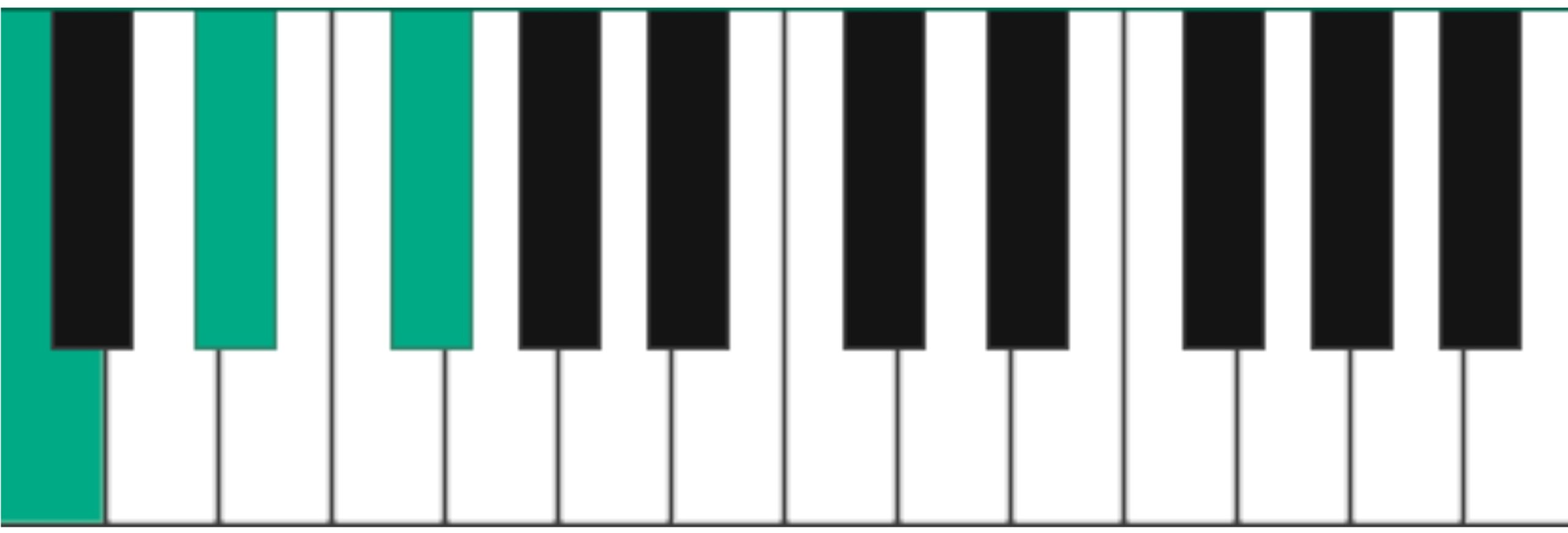
F diminished
If we start from the root note F and count up a minor third, we reach A♭. A minor third above A♭ is C♭. This means that an F diminished triad (F dim) is spelled F – A♭ – C♭.
When we spell the notes of the chord, we must use the properscale degrees and enharmonic spelling. C is the fifth scale degree of F, so we need to spell the chord from the root, C, even though C♭ and B are enharmonic equivalents (share pitch). If we spelled the F diminished chord F – A♭ – B, that would mean the formula for the diminished chord is 1 – ♭3 – ♯4.
Now we have covered a couple of examples, try figuring out a few more diminished chords yourself. You can check them against our handy diminished chord chart.
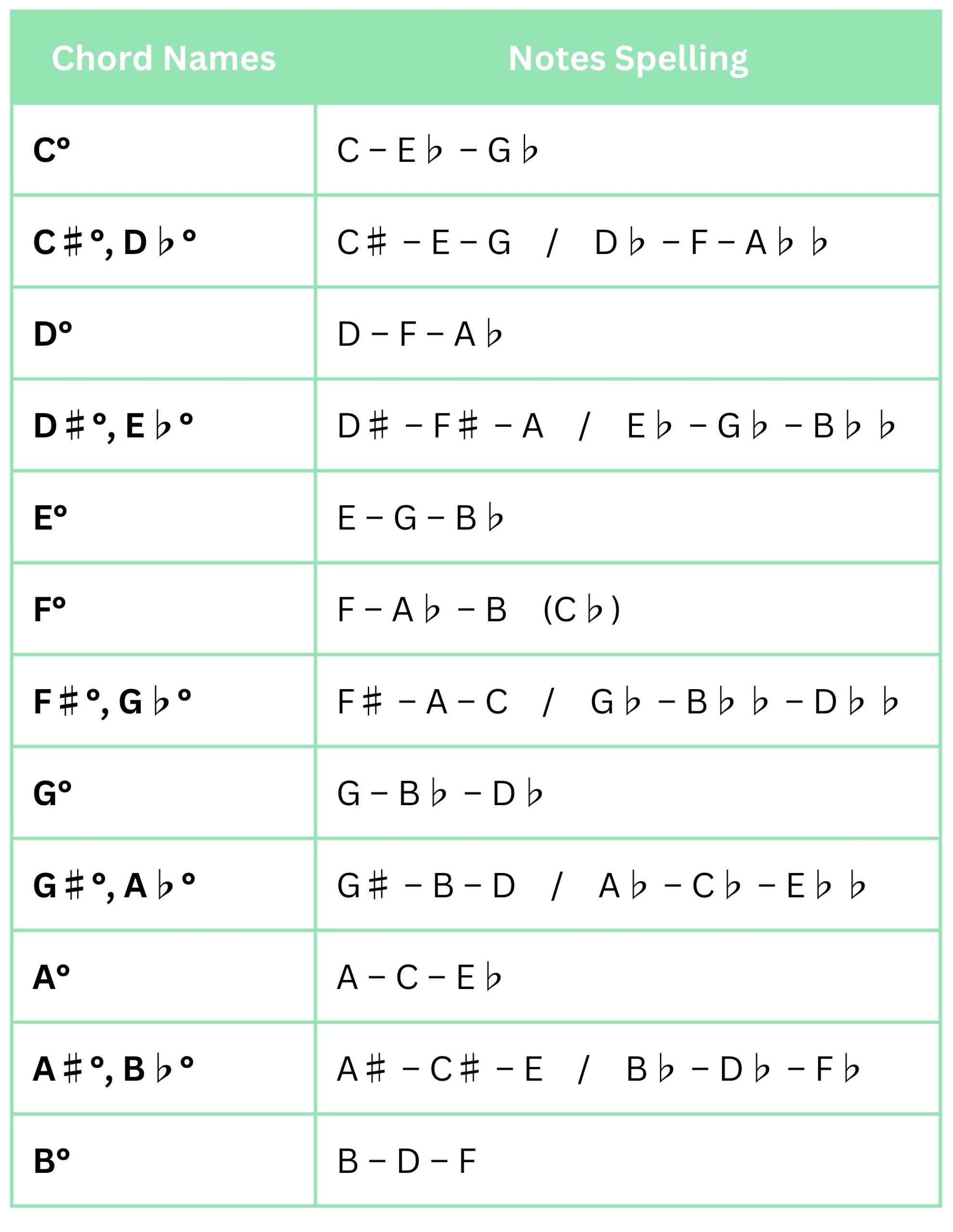
Now we have had a closer look at the diminished triad, it is time to look at the variants of the diminished chord.
The diminished seventh chord (°7)
The diminished seventh chord adds a note to the diminished triad we have already looked at. It is notated with a ‘°7’ symbol to show the addition of a 7th degree. The diminished seventh chord is built by adding another interval on top of our triad much like any other chord extension. The Ab is a diminished seventh interval from the root of this chord. This is where this chord gets its name from. These chords often occur in minor harmony, especially the harmonic minor scale.
This means a B diminished chord will consist of:
B – D – F and Ab
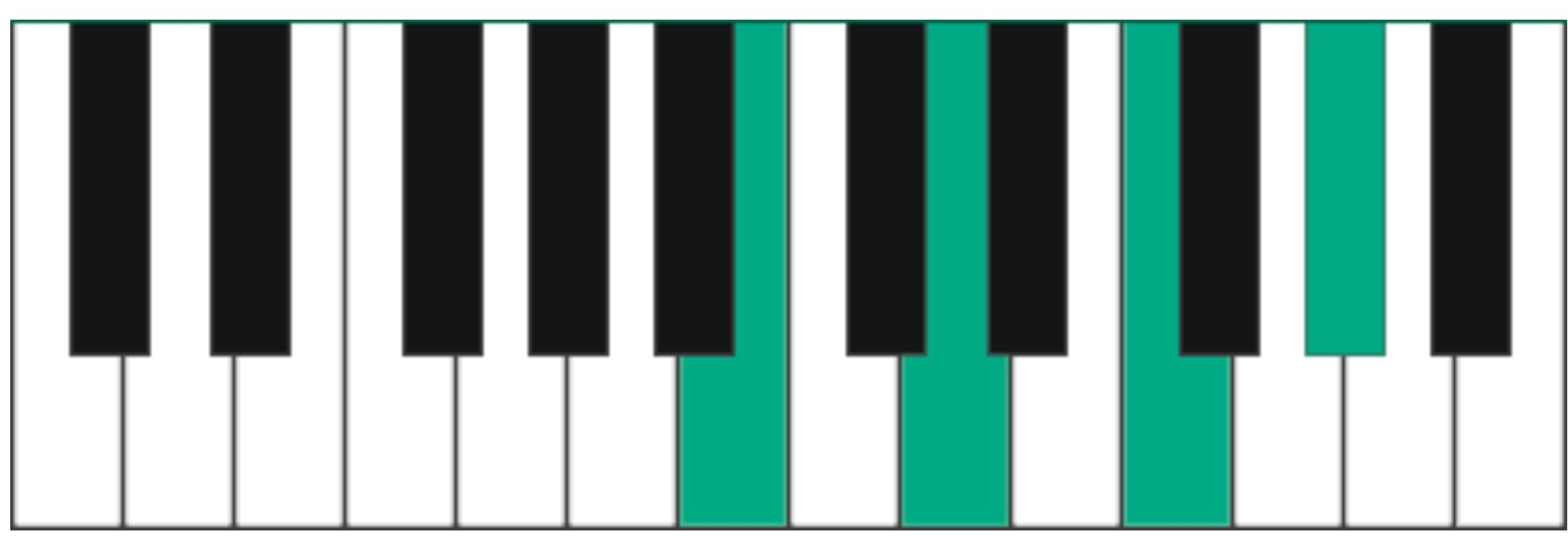
The diminished seven chord formula is: 1 – ♭3 – ♭7 – ♭♭7.
Again, the spelling is important here; using the scale degrees properly shows the diminished quality of the 7th of this chord. Don’t worry though, Skoove has got you covered with this table of all the diminished 7 chords.
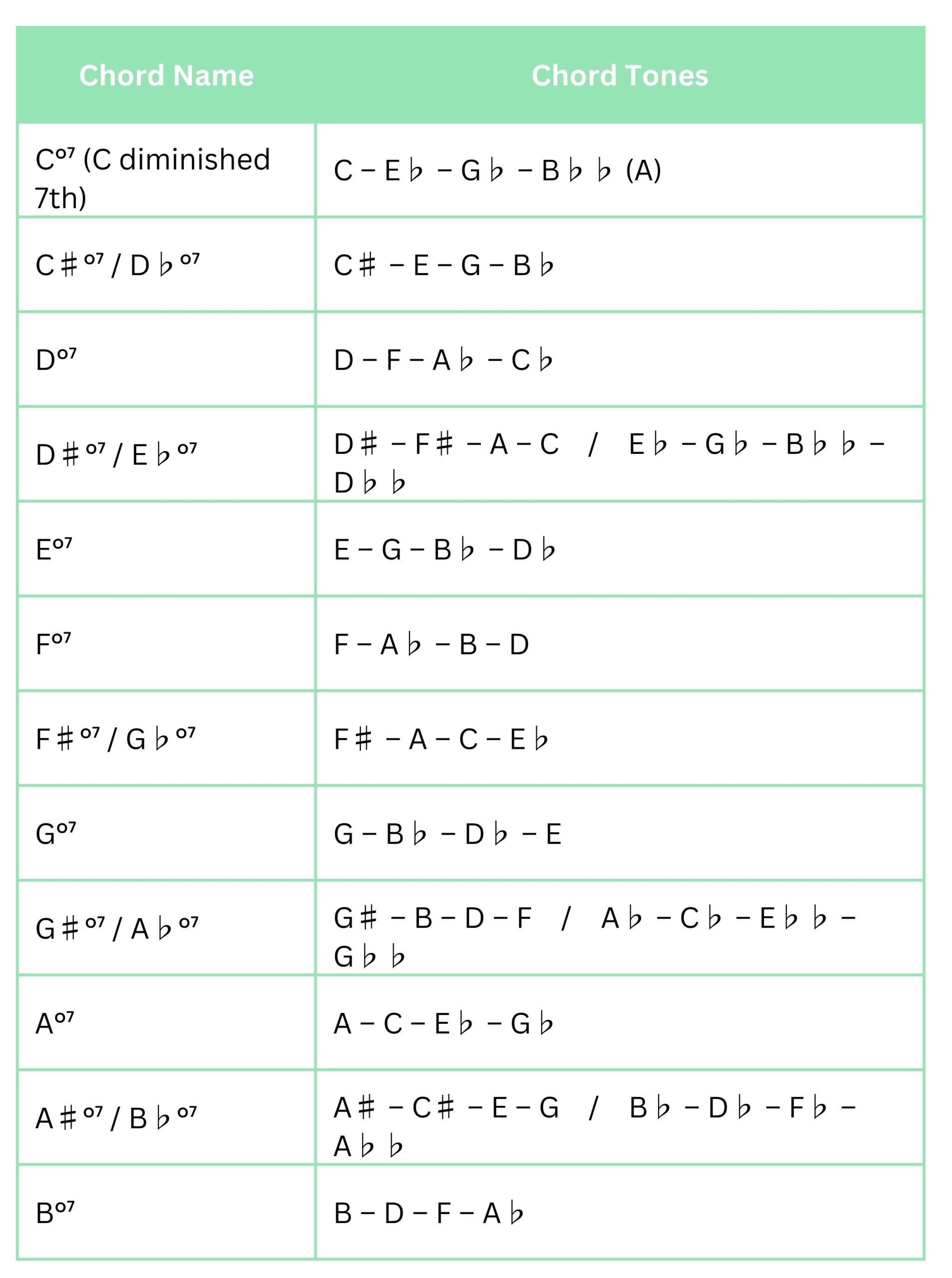
Dim chords are interesting to play around with, you can learn more about them withonline piano lessons.
The half-diminished chord (m7♭5)
The half diminished seventh chord is found as the second degree of the minor scale and is often used in the minor ii V i in jazz. It can be written as a chord symbol either as a ‘ø’ or as ‘m7b5’.
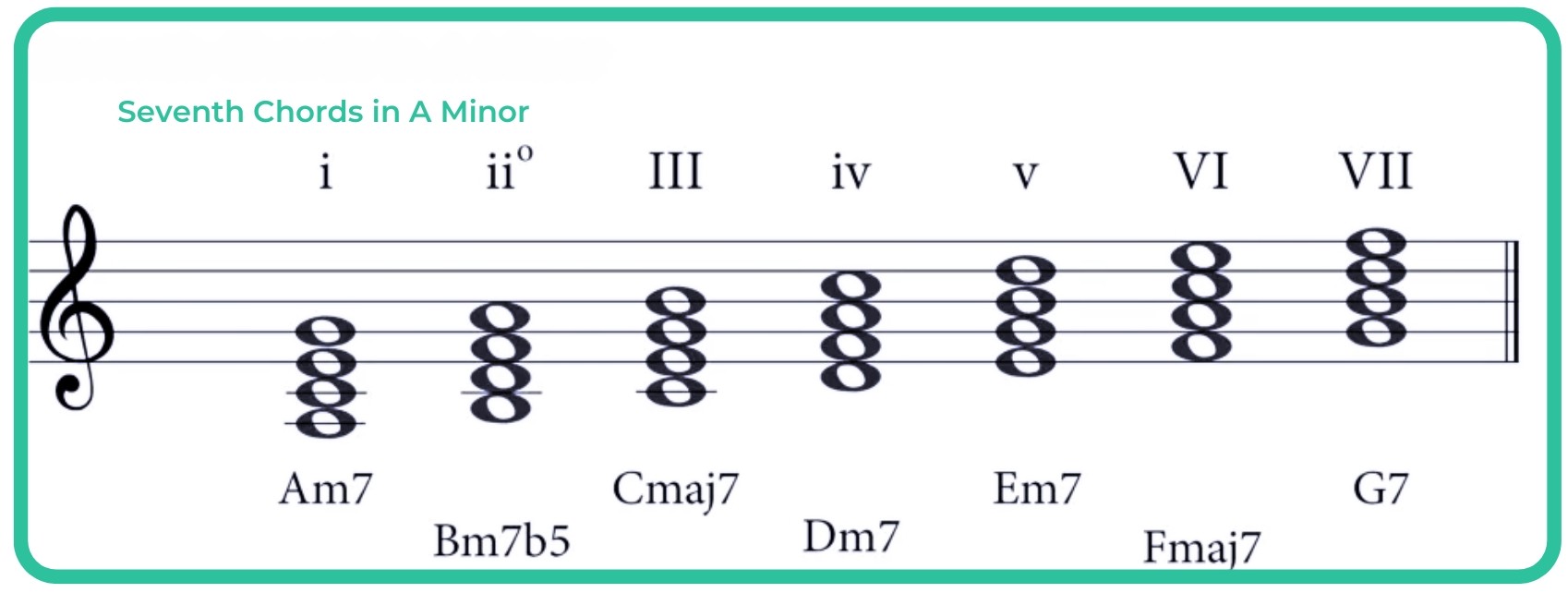
This chord is constructed by stacking a major third on top of the diminished triad creating a minor seventh from the root.
B – (minor third ) – D – (minor third ) – F – (major third ) – A
Or from the root
A – minor seventh
F – diminished fifth
D – minor third
B – Root
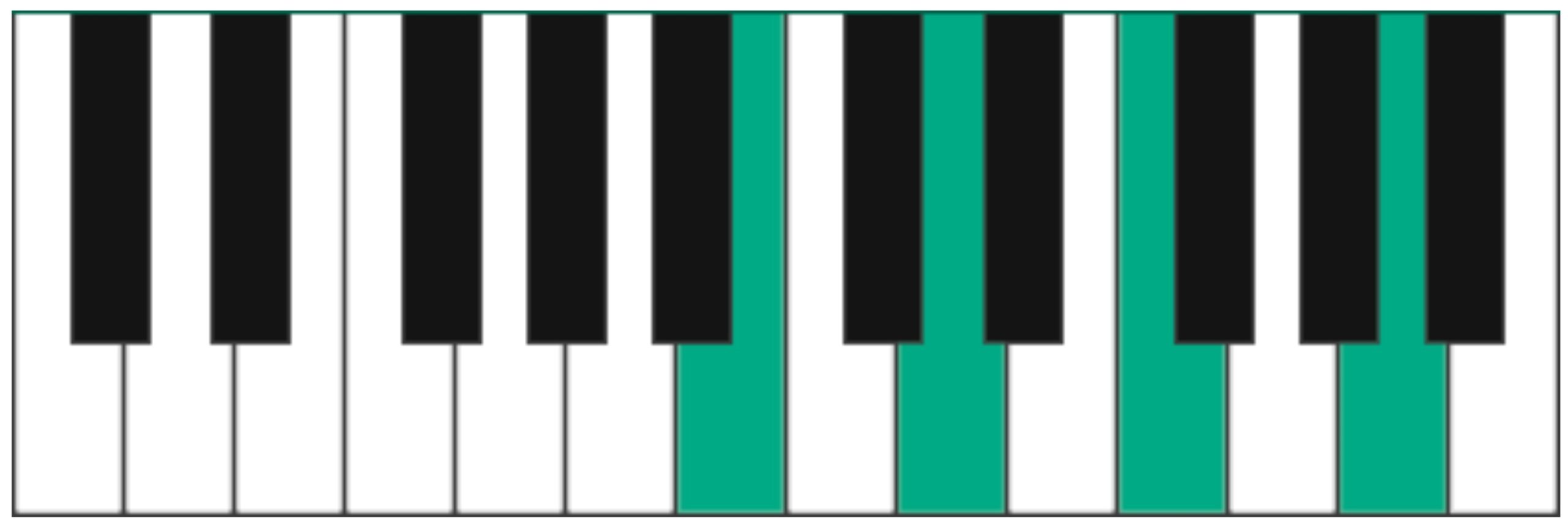
The half diminished chord formula is: 1 – ♭3 – ♭7 – ♭7.
These chords are called minor seven flat five chords as they follow the formula of the minor seventh chord but have a lowered fifth degree. They are also referred to as half diminished chords as they sit half way between the minor seven chord and the fully diminished seven chord. Here is a list of all 12 half diminished seventh chords.
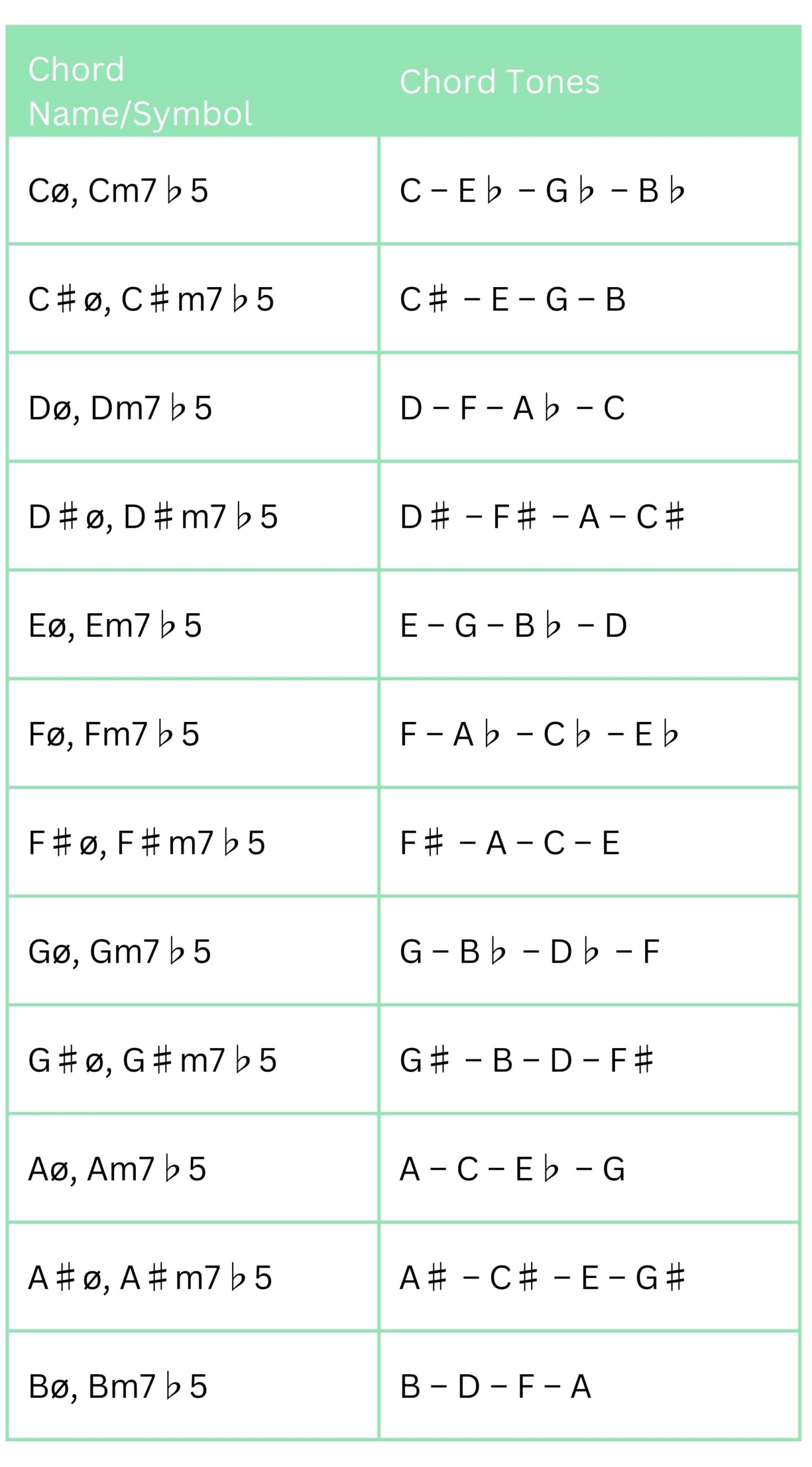
How to practice diminished chords?
Let’s take a look at how we can further understand diminished chords in music by practicing with them and using them in some common chord progressions.
As we have seen, in a chord progression, we can use these diminished chords in the same way we would use a dominant chord. For example you could swap out a G major chord in a C major progression.
C major – A minor – F major – G major
For a diminished chord:
C major – A minor – F major – B diminished
You can replace a dominant chord (chord five in a key) with a diminished chord built on the third of that chord, in this case the B of the G major chord. This introduces the diminished chord as an interesting substitute for the G major.
You can use diminished chords into your progressions, which will help make your songs more interesting when youlearn how to play piano.
The best place to practice all the chords we have talked about in this article is to use the Skoove app. The diminished chord occurs in all genres from classical to pop and jazz. With help from our app, guidance and real time feedback you will have these beautiful chords mastered in no time. Try these examples of songs with diminished chords and you will experience them in the context of some of your favorite classical tunes.
Diminished vs. augmented chords
The diminished and augmented chord are two very different sounding chords and are notated with either the letter ‘aug’ or a ‘+’ symbol. However, they are similar in the fact that they both are made up of stacks of the same interval. As we have seen the diminished chord is made of minor thirds the augmented triad we see here is made up of a stack of major thirds.
If we stack major thirds form C we get C E and G#
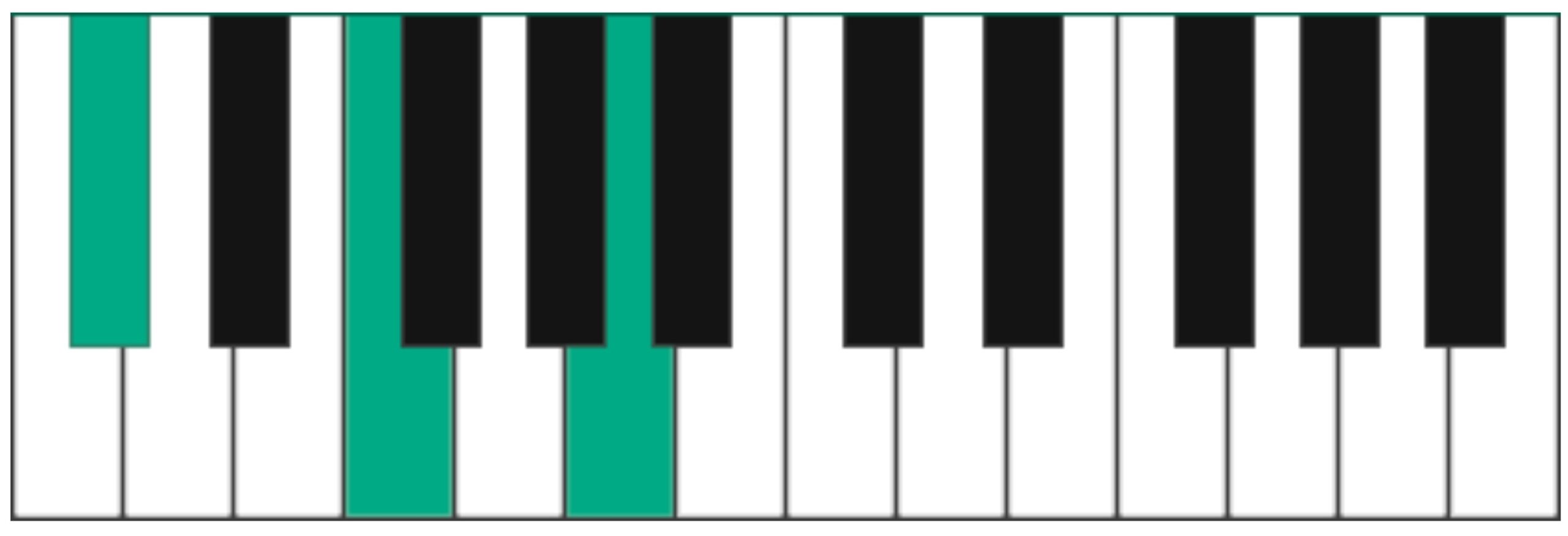
The formula for an augmented chord is: 1 – 3 – #5
Try playing this back to back with C diminished and pay attention to the difference in sound. The augmented triad can also be used as a substitute for dominant chords in chord progressions. You can try using both B dim and C aug in place of a G chord (the dominant chord in C) in this progression.
C major – A minor – F major – G major
C major – A minor – F major – B diminished
C major – A minor – F major – G Augmented (G B D#)
The diminished chord is an important concept in music theory. Learning how to incorporate it in your songs and playing can heighten the emotional depths of your music and make your playing sound more advanced.
You can always learn more about music theory and more advanced chords with Skoove. Check out the interactive lessons on chords, scales and progressions and dive deeper into music theory today. Keep up the good work!
Author of this blog post:
Matthew Dickman

With over a decade of experience in music education Matthew holds a BA in Music from Paul McCartney’s LIPA and an MA in Composition from the University of Salford. Mathew has developed a distinctive compositional voice and approach to music theory education through his research and work in the music industry. Matthew’s writing for Skoove combines experience from orchestral and media composition, and as a gigging jazz musician, to create a wholistic and accessible pedagogy for musicians of any level. Away from music, he enjoys reading and exploring nature to expand his horizons and knowledge contributing to his holistic teaching style.















